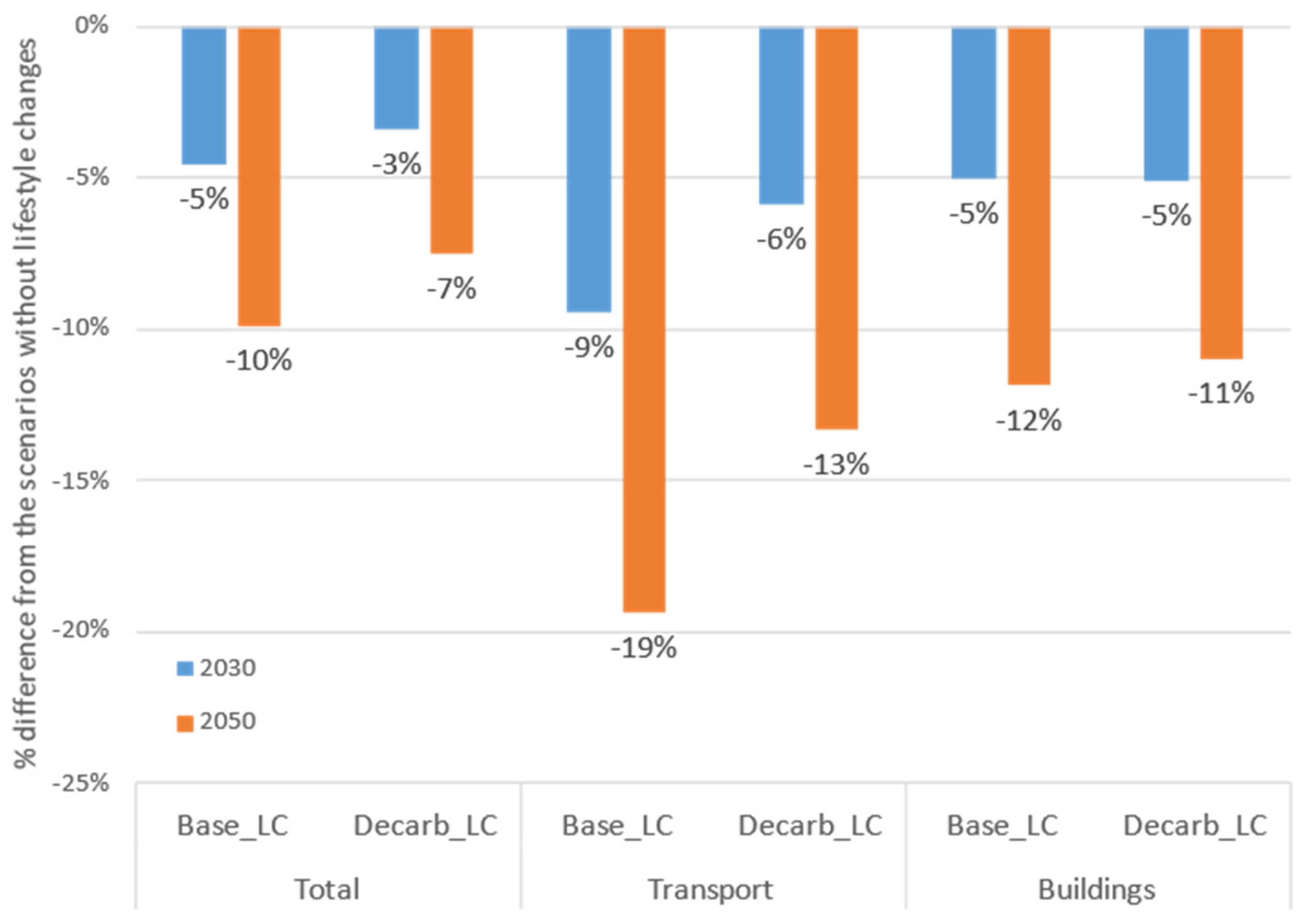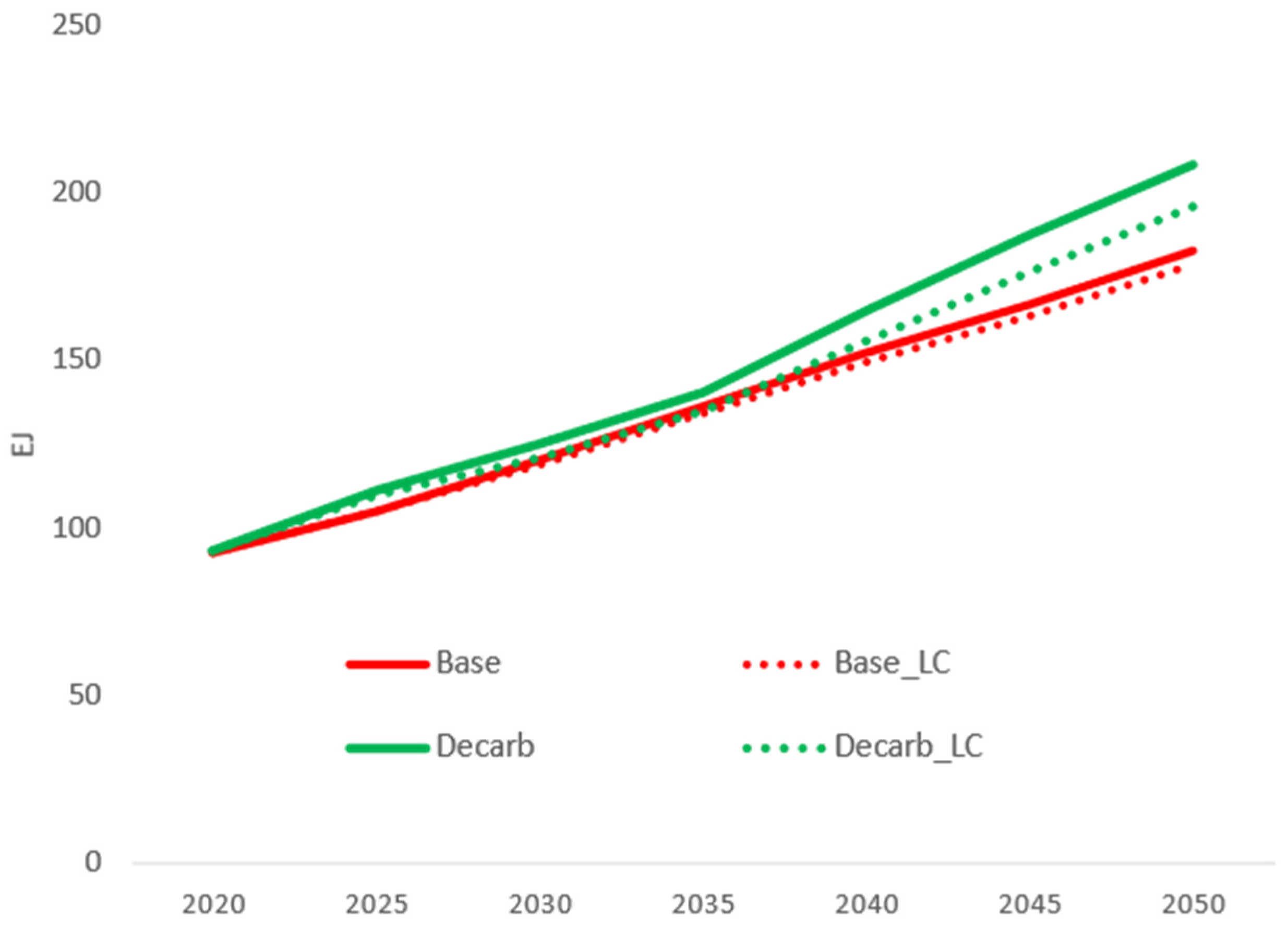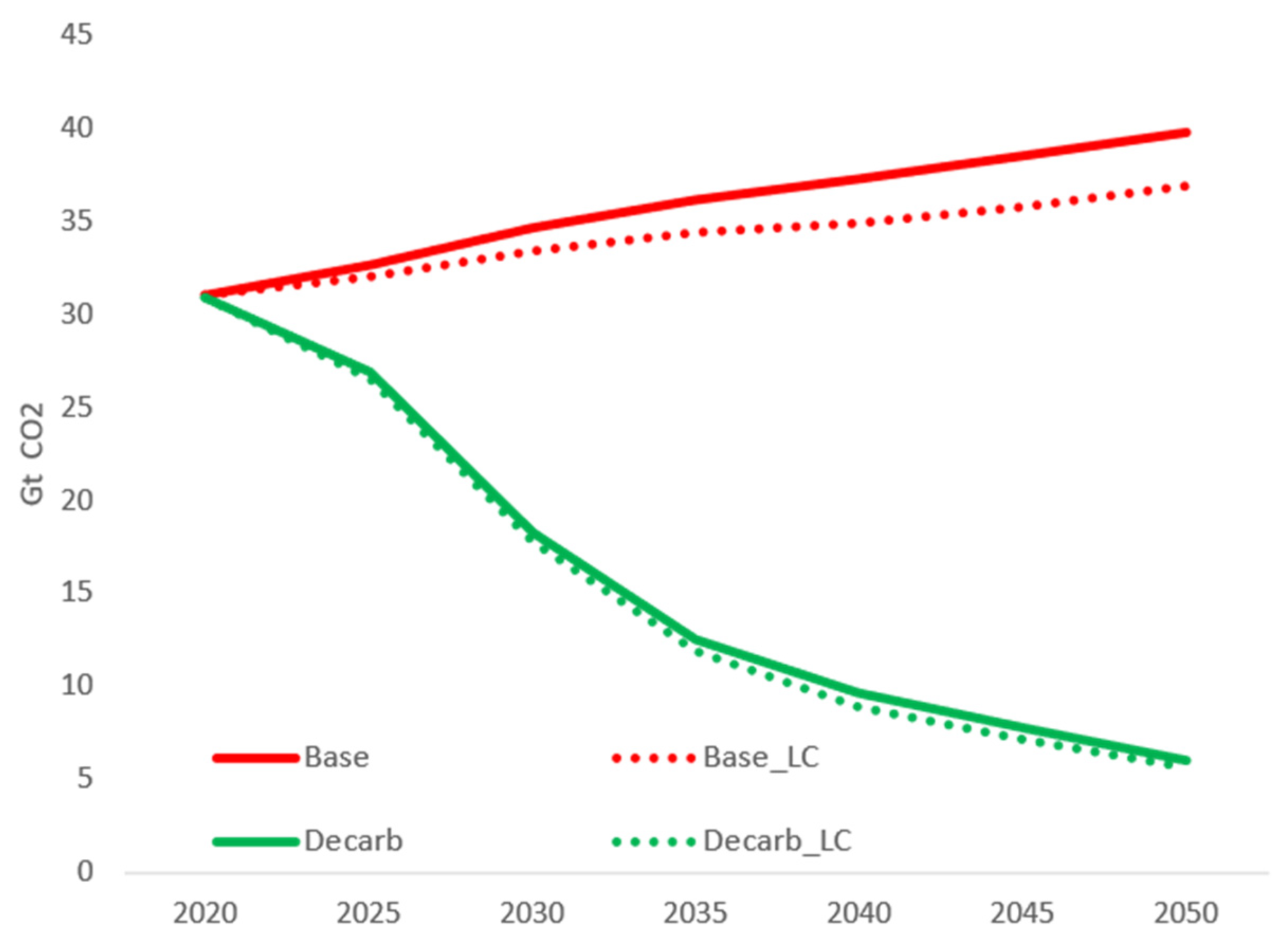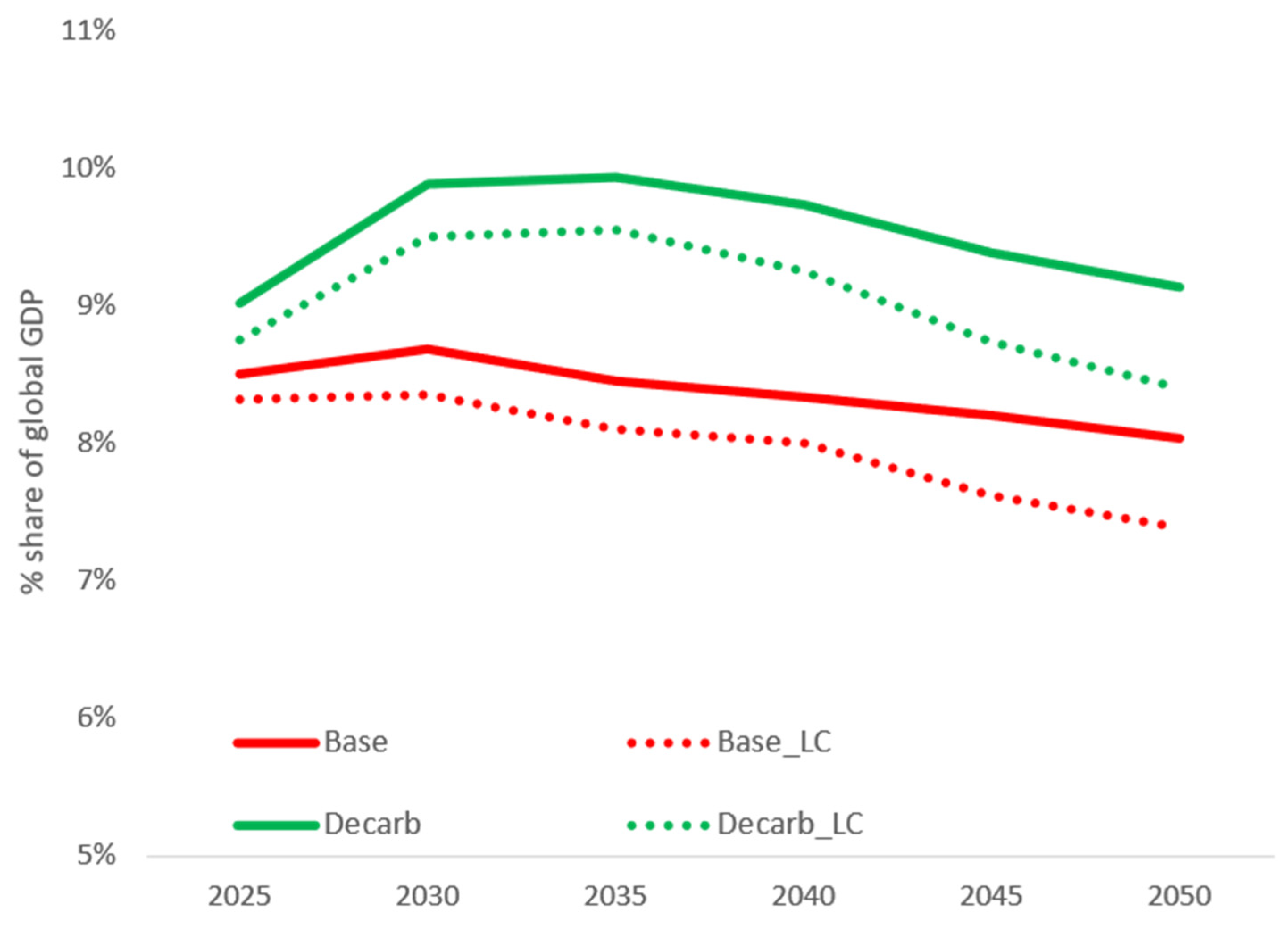Exploring the Impacts of Lifestyle Changes in the Global Energy Transition: Insights from a Model-Based Analysis Using PROMETHEUS
Abstract
1. Introduction
2. Materials and Methods
2.1. PROMETHEUS Model Description
- European Union (+Norway and Switzerland)
- China
- India
- North America (USA and Canada)
- Western Pacific (Japan, Republic of Korea, Australia, New Zealand)
- Commonwealth of Independent States (e.g., the Former Soviet Union, excluding the Baltic Republics)
- The Middle East (from the Mediterranean to the Iranian border with Afghanistan and Pakistan) and North Africa (Egypt, Libya, Tunisia, Algeria, Morocco)
- Emerging Economies: This region broadly includes Türkiye, almost the whole of Latin America, Southeast Asia (excluding Indonesia), and Southern Africa.
- Rest of world: All other countries, mostly in Africa and South East Asia.
2.2. Data Sources
2.3. Scenario Design
3. Model-Based Results
3.1. Impacts on Energy Consumption
3.2. Impacts on Energy Supply
3.3. Impacts on CO2 Emissions
3.4. Impacts on Energy System Costs
4. Discussion
5. Conclusions, and Future Work
Author Contributions
Funding
Data Availability Statement
Acknowledgments
Conflicts of Interest
Glossary
| NOAM | North America (USA, Canada) |
| WPAC | Western Pacific (Japan, Republic of Korea, Australia, New Zealand) |
| CHN | China |
| IND | India |
| CIS | Russia and Community of Independent States |
| Rest | Rest of the world. |
References
- UNFCCC. COP 28: What Was Achieved and What Happens Next? 2015. Available online: https://unfccc.int/cop28/5-key-takeaways#:~:text=COP%2028%20closed%20with%20an,As%20COP%2028%20President%20Dr (accessed on 2 September 2024).
- Hassan, Q.; Viktor, P.; Al-Musawi, T.J.; Ali, B.M.; Algburi, S.; Alzoubi, H.M.; Al-Jiboory, A.K.; Sameen, A.Z.; Salman, H.M.; Jaszczur, M. The renewable energy role in the global energy Transformations. Renew. Energy Focus 2024, 48, 100545. [Google Scholar] [CrossRef]
- Ibekwe, K.I.; Umoh, A.A.; Nwokediegwu, Z.Q.S.; Etukudoh, E.A.; Ilojianya, V.I.; Adefemi, A. Energy Efficiency in Industrial Sectors: A Review of Technologies and Policy Measures. Eng. Sci. Technol. J. 2024, 5, 169–184. [Google Scholar] [CrossRef]
- Kohlscheen, E.; Moessner, R.; Takats, E. Effects of carbon pricing and other climate policies on CO2 emissions. arXiv 2024, arXiv:2402.03800. [Google Scholar]
- Capstick, S.; Khosla, R.; Wang, S.; den Berg, N.V.; Ivanova, D.; Otto, I.M.; Gore, T.; Corner, A.; Akenji, L.; Hoolohan, C.; et al. Chapter 6. Bridging the Gap: The Role of Equitable Low-Carbon Lifestyles. In Emissions Gap Report 2020. United Nations Environment Programme. Nairobi (9) (PDF) UNEP Emissions Gap Report 2020 Bridging the Gap: The Role of Equitable Low-carbon Lifestyles. 2020. Available online: https://www.researchgate.net/publication/348448170_UNEP_Emissions_Gap_Report_2020_Bridging_the_gap_the_role_of_equitable_low-carbon_lifestyles (accessed on 3 September 2024).
- Creutzig, F.; Niamir, L.; Bai, X.; Callaghan, M.; Cullen, J.; Díaz-José, J.; Figueroa, M.; Grubler, A.; Lamb, W.F.; Leip, A.; et al. Demand-side solutions to climate change mitigation consistent with high levels of well-being. Nat. Clim. Chang. 2021, 12, 36–46. [Google Scholar] [CrossRef]
- Creutzig, F.; Roy, J.; Minx, J. Demand-side climate change mitigation: Where do we stand and where do we go? Environ. Res. Lett. 2024, 19, 040201. [Google Scholar] [CrossRef]
- IEA. Global Energy and Climate Model; IEA: Paris, France, 2023; Available online: https://www.iea.org/reports/global-energy-and-climate-model (accessed on 1 September 2024).
- Samadi, S.; Gröne, M.-C.; Schneidewind, U.; Luhmann, H.-J.; Venjakob, J.; Best, B. Sufficiency in energy scenario studies: Taking the potential benefits of lifestyle changes into account. Technol. Forecast. Soc. Chang. 2017, 124, 126–134. [Google Scholar] [CrossRef]
- UNFCCC. Adoption of the Paris Agreement, 21st Conference of the Parties, Paris: United Nations Framework Convention on Climate Change (UNFCCC). Adoption Official the Publarics Agreemention. 2015. Available online: https://unfccc.int/resource/docs/2015/cop21/eng/l09r01.pdf (accessed on 1 September 2024).
- Andreou, A.; Fragkos, P.; Fotiou, T.; Filippidou, F. Assessing Lifestyle Transformations and Their Systemic Effects in Energy-System and Integrated Assessment Models: A Review of Current Methods and Data. Energies 2022, 15, 4948. [Google Scholar] [CrossRef]
- Freeman, R.; Pye, S. Socio-technical modelling of UK energy transition under three global SSPs, with implications for IAM scenarios. Environ. Res. Lett. 2022, 17, 124022. [Google Scholar] [CrossRef]
- Berg, N.J.v.D.; Hof, A.F.; Akenji, L.; Edelenbosch, O.Y.; van Sluisveld, M.A.; Timmer, V.J.; van Vuuren, D.P. Improved modelling of lifestyle changes in Integrated Assessment Models: Cross-disciplinary insights from methodologies and theories. Energy Strat. Rev. 2019, 26, 100420. [Google Scholar] [CrossRef]
- Berg, N.J.v.D.; Hof, A.F.; Timmer, V.; Akenji, L.; van Vuuren, D.P. (Path)ways to sustainable living: The impact of the SLIM scenarios on long-term emissions. Glob. Environ. Chang. 2023, 84, 102774. [Google Scholar] [CrossRef]
- Anable, J.; Brand, C.; Eyre, N.; Layberry, R.; Bergman, N.; Strachan, N.; Fa wcett, T.; Tran, M. Energy 2050—WG1 Energy Demand Lifestyle and Energy Consumption. Available online: https://ukerc.rl.ac.uk/UCAT/PUBLICATIONS/Energy_2050_-_WG1_Energy_Demand_Lifestyle_and_Energy_Consumption.pdf (accessed on 2 September 2024).
- Net Zero Government Initiative UK Roadmap to Net Zero Government Emissions. 2023. Available online: https://assets.publishing.service.gov.uk/media/6569cb331104cf000dfa7352/net-zero-government-emissions-roadmap.pdf (accessed on 1 September 2024).
- Huckebrink, D.; Bertsch, V. Integrating Behavioural Aspects in Energy System Modelling—A Review. Energies 2021, 14, 4579. [Google Scholar] [CrossRef]
- Fragkos, P.; Kouvaritakis, N.; Capros, P. Incorporating Uncertainty into World Energy Modelling: The PROMETHEUS Model. Environ. Model. Assess. 2015, 20, 549–569. [Google Scholar] [CrossRef]
- Fragkos, P.; Longa, F.D.; Zisarou, E.; van der Zwaan, B.; Giannousakis, A.; Fattahi, A. Exploring Model-Based Decarbonization and Energy Efficiency Scenarios with PROMETHEUS and TIAM-ECN. Energies 2023, 16, 6421. [Google Scholar] [CrossRef]
- Longa, F.D.; Fragkos, P.; Nogueira, L.P.; van der Zwaan, B. System-level effects of increased energy efficiency in global low-carbon scenarios: A model comparison. Comput. Ind. Eng. 2022, 167, 108029. [Google Scholar] [CrossRef]
- Fragkos, P.; Siskos, P. Energy Systems Analysis and Modelling towards Decarbonisation. Energies 2022, 15, 1971. [Google Scholar] [CrossRef]
- Andreou, A. Report on the Updated System Models in Mobility and Residential Demand and Their Results. Deliverable 6.1 of the CAMPAIGNers Project Funded Under the European Union’s Horizon 2020 Research and Innovation Programme GA No: 101003815.2023. Available online: https://project.climate-campaigners.com/Publications (accessed on 1 September 2024).
- Fricko, O.; Havlik, P.; Rogelj, J.; Klimont, Z.; Gusti, M.; Johnson, N.; Kolp, P.; Strubegger, M.; Valin, H.; Amann, M. The marker quantification of the Shared Socioeconomic Pathway 2: A middle-of-the-road scenario for the 21st century. Glob. Environ. Chang. 2017, 42, 251–267. Available online: https://www.sciencedirect.com/science/article/pii/S0959378016300784 (accessed on 7 December 2018). [CrossRef]
- Dafnomilis, I.; Chen, H.-H.; Elzen, M.D.; Fragkos, P.; Chewpreecha, U.; van Soest, H.; Fragkiadakis, K.; Karkatsoulis, P.; Paroussos, L.; de Boer, H.-S.; et al. Targeted Green Recovery Measures in a Post-COVID-19 World Enable the Energy Transition. Front. Clim. 2022, 4, 840933. [Google Scholar] [CrossRef]
- EU Reference Scenario 2020. Energy, Transport and GHG Emissions: Trends to 2050; Publications Office: Luxembourg, 2021. [Google Scholar] [CrossRef]
- European Commission. The 2021 Ageing Report, Economic & Budgetary Projections for the EU Member States (2019–2070). 2021. Available online: https://economy-finance.ec.europa.eu/system/files/2021-10/ip148_en.pdf (accessed on 1 September 2024).
- European Commission. European Economic Forecast. Spring 2020. Available online: https://economy-finance.ec.europa.eu/publications/european-economic-forecast-spring-2020_en#:~:text=Description,by%20around%206%25%20in%202021 (accessed on 1 September 2024).
- Eurostat, Short-Term Update of the Projected Population (2022–2032). 2023. Available online: https://ec.europa.eu/eurostat/databrowser/view/PROJ_STP22/default/table?lang=en&category=proj.proj19n (accessed on 1 September 2024).
- European Commission. European Economic Forecast. Autumn 2022. Available online: https://economy-finance.ec.europa.eu/economic-forecast-and-surveys/economic-forecasts/autumn-2022-economic-forecast-eu-economy-turning-point_en (accessed on 1 September 2024).
- Rogelj, J.; Shindell, D.; Jiang, K.; Fifita, S.; Forster, P.; Ginzburg, V.; Handa, C.; Kheshgi, H.; Kobayashi, S.; Kriegler, E.; et al. Mitigation Pathways Compatible with 1.5 °C in the Context of Sustainable Development. In Global Warming of 1.5 °C; An IPCC Special Report on the impacts of global warming of 1.5 °C above pre-industrial levels and related global greenhouse gas emission pathways, in the context of strengthening the global response to the threat of climate change, sustainable development, and efforts to eradicate poverty; Masson-Delmotte, V.P., Zhai, H.-O., Pörtner, D., Roberts, J., Skea, P.R., Shukla, A., Pirani, W., Moufouma-Okia, C., Péan, R., Pidcock, S., et al., Eds.; Cambridge University Press: Cambridge, UK, 2018. [Google Scholar] [CrossRef]
- van Soest, H.L.; Elzen, M.G.J.D.; van Vuuren, D.P. Net-zero emission targets for major emitting countries consistent with the Paris Agreement. Nat. Commun. 2021, 12, 2140. [Google Scholar] [CrossRef]
- IPCC. 2023: Climate Change 2023: Synthesis Report. In Contribution of Working Groups I, II and III to the Sixth Assessment Report of the Intergovernmental Panel on Climate Change; Core Writing Team, Lee, H., Romero, J., Eds.; IPCC: Geneva, Switzerland, 2023; 184p. [Google Scholar] [CrossRef]
- Campaigners Project. Available online: https://project.climate-campaigners.com/ (accessed on 12 July 2024).
- NAVIGATE Project. Available online: https://www.navigate-h2020.eu/ (accessed on 12 July 2024).
- Replogle, M.A.; Fulton, L.M. A Global High Shift Scenario: Impacts and Potential for More Public Transport, Walking, and Cycling with Lower Car Use. 2014. Available online: https://theicct.org/sites/default/files/A%20Global%20High%20Shift%20Scenario_WEB.pdf (accessed on 12 July 2024).
- Mulholland, E.; Teter, J.; Cazzola, P.; McDonald, Z.; Gallachóir, B.P. The long haul towards decarbonising road freight—A global assessment to 2050. Appl. Energy 2018, 216, 678–693. [Google Scholar] [CrossRef]
- Kikstra, J.S.; Vinca, A.; Lovat, F.; Boza-Kiss, B.; van Ruijven, B.; Wilson, C.; Rogelj, J.; Zakeri, B.; Fricko, O.; Riahi, K. Climate mitigation scenarios with persistent COVID-19-related energy demand changes. Nat. Energy 2021, 6, 1114–1123. [Google Scholar] [CrossRef]
- Akimoto, K.; Sano, F.; Oda, J. Impacts of ride and car-sharing associated with fully autonomous cars on global energy consumptions and carbon dioxide emissions. Technol. Forecast. Soc. Chang. 2022, 174, 121311. [Google Scholar] [CrossRef]
- Levesque, A.; Pietzcker, R.C.; Luderer, G. Halving energy demand from buildings: The impact of low consumption practices. Technol. Forecast. Soc. Chang. 2019, 146, 253–266. [Google Scholar] [CrossRef]
- Fishman, T.; Heeren, N.; Pauliuk, S.; Berrill, P.; Tu, Q.; Wolfram, P.; Hertwich, E.G. A comprehensive set of global scenarios of housing, mobility, and material efficiency for material cycles and energy systems modeling. J. Ind. Ecol. 2021, 25, 305–320. [Google Scholar] [CrossRef]
- Grubler, A.; Wilson, C.; Bento, N.; Boza-Kiss, B.; Krey, V.; McCollum, D.L.; Rao, N.D.; Riahi, K.; Rogelj, J.; De Stercke, S.; et al. A low energy demand scenario for meeting the 1.5 °C target and sustainable development goals without negative emission technologies. Nat. Energy 2018, 3, 515–527. [Google Scholar] [CrossRef]
- Mastrucci, A.; van Ruijven, B.; Byers, E.; Poblete-Cazenave, M.; Pachauri, S. Global scenarios of residential heating and cooling energy demand and CO2 emissions. Clim. Chang. 2021, 168, 14. [Google Scholar] [CrossRef]
- Shahmohammadi, S.; Steinmann, Z.; King, H.; Hendrickx, H.; Huijbregts, M.A. The influence of consumer behavior on energy, greenhouse gas, and water footprints of showering. J. Ind. Ecol. 2019, 23, 1186–1195. [Google Scholar] [CrossRef]
- LBNL (No Date) Products That Use Standby Power, List of Standby Products. Available online: https://standby.lbl.gov/standby-power-data-metering (accessed on 1 September 2024).
- European Council. Latest EU Policy Actions on Climate Change. Available online: https://www.consilium.europa.eu/en/policies/climate-change/eu-climate-action/ (accessed on 2 September 2024).
- European Commission. 2050 Long-Term Strategy. Available online: https://climate.ec.europa.eu/eu-action/climate-strategies-targets/2050-long-term-strategy_en#:~:text=Striving%20to%20become%20the%20world’s%20first%20climate%2Dneutral%20continent%20by%202050.&text=The%20EU%20aims%20to%20be,to%20the%20European%20Climate%20Law%20 (accessed on 2 September 2024).
- Fragkos, P.; van Soest, H.L.; Schaeffer, R.; Reedman, L.; Köberle, A.C.; Macaluso, N.; Evangelopoulou, S.; De Vita, A.; Sha, F.; Qimin, C.; et al. Energy system transitions and low-carbon pathways in Australia, Brazil, Canada, China, EU-28, India, Indonesia, Japan, Republic of Korea, Russia and the United States. Energy 2020, 216, 119385. [Google Scholar] [CrossRef]
- Nuţă, F.M.; Sharafat, A.; Abban, O.J.; Khan, I.; Irfan, M.; Nuţă, A.C.; Dankyi, A.B.; Asghar, M. The relationship among urbanization, economic growth, renewable energy consumption, and environmental degradation: A comparative view of European and Asian emerging economies. Gondwana Res. 2023, 128, 325–339. [Google Scholar] [CrossRef]
- Yadav, A.; Mahalik, M.K. Does renewable energy development reduce energy import dependency in emerging economies? Evidence from CS-ARDL and panel causality approach. Energy Econ. 2024, 131, 107356. [Google Scholar] [CrossRef]
- Creutzig, F.; Fernandez, B.; Haberl, H.; Khosla, R.; Mulugetta, Y.; Seto, K.C. Beyond Technology: Demand-Side Solutions for Climate Change Mitigation. Annu. Rev. Environ. Resour. 2016, 41, 173–198. [Google Scholar] [CrossRef]
- Mundaca, L.; Ürge-Vorsatz, D.; Wilson, C. Demand-side approaches for limiting global warming to 1.5 °C. Energy Effic. 2018, 12, 343–362. [Google Scholar] [CrossRef]
- Gota, S.; Huizenga, C.; Peet, K.; Medimorec, N.; Bakker, S. Decarbonising transport to achieve Paris Agreement targets. Energy Effic. 2018, 12, 363–386. [Google Scholar] [CrossRef]
- Lamb, W.F.; Grubb, M.; Diluiso, F.; Minx, J.C. Countries with sustained greenhouse gas emissions reductions: An analysis of trends and progress by sector. Clim. Policy 2021, 22, 1–17. [Google Scholar] [CrossRef]
- IEA. World Energy Outlook 2021, Paris 2021. Available online: https://www.iea.org/reports/world-energy-outlook-2021 (accessed on 20 July 2024).
- Hooftman, N.; Messagie, M.; Van Mierlo, J.; Coosemans, T. A review of the European passenger car regulations—Real driving emissions vs local air quality. Renew. Sustain. Energy Rev. 2018, 86, 1–21. [Google Scholar] [CrossRef]
- Wang, Y.; He, Z.; Zou, J.; Xie, H.; Bao, J. Energy Transition for Sustainable Economy: What is the Role of Government Governance and Public Concern? Financ. Res. Lett. 2024, 69, 106087. [Google Scholar] [CrossRef]








| Scenario | Design and Rationale | Source of Targets and Policies |
|---|---|---|
| Baseline (Base) | This scenario represents the continuation of existing climate policies, reflecting the National Energy and Climate Plans (NECPs) and Long-Term Renovation Strategies of EU countries and currently implemented policies as described in [24]. Policies are compatible with the latest EU Reference scenario which provides a benchmark for assessing energy, environmental and climate projections. Non-EU countries follow their currently implemented policies [31]. | The EU Reference scenario data and methodologies were used to capture existing commitments, targets, and measures of the latest available data, including policies like the Renewable Energy Directive (RED II) and the Energy Efficiency Directive (EED). For non-EU countries, currently implemented policies from the basis, drawing on international databases and policy reviews to represent each country’s commitments to climate and energy policy. |
| Decarbonization (Decarb) | This scenario is structured to model the pathway required to meet stringent climate targets that align with limiting global warming to 1.5 °C. The decarbonization pathway is informed by a global carbon budget of 650 Gt CO2 from 2020–2100 (which is imposed globally to limit global warming to 1.5 °C) (based on IPCC, AR6) [32]. This budget constraint imposes a reduction trajectory designed to ensure compatibility with ambitious temperature targets globally. Within the EU, the scenario incorporates the 55% GHG reduction target by 2030, in line with the European Climate Law and the Fit for 55 package. This includes specific policies aimed at increasing renewable energy and energy efficiency, while also integrating carbon pricing mechanisms through the EU Emission Trading System (ETS) for both ETS1 and ETS2 sectors. | The scenario reflects key measures outlined in the Fit For 55 legislative package, including updates to the ETS, the Social Climate Fund, and sector-specific regulatory measures for transport, industry, and buildings. Additionally, the carbon budget and policy measures are derived from a combination of IPCC recommendations for a 1.5 °C pathway and the EU policy documents (e.g., the European Green Deal and Climate Target Plan 2030), as well as insights from sectoral studies on decarbonization in the EU. |
| Step | Process | Description |
|---|---|---|
| 1 | Empirical data and survey insights | Data from user-driven sources, including the Campaigners app, provided real-world insights into current and potential future behavior patterns. These data [11] highlighted trends in energy consumption, transport choices, and home energy efficiency practices, serving as a foundation for realistic lifestyle scenarios. |
| 2 | Behavioral literature and best practices | The scenarios were informed by studies on sustainable behaviors and adoption rates of lifestyle changes, with reference to documented trends in behavioral economics and social sciences. This literature provided parameters for likely shifts in areas like public transport adoption, reduced car dependency, and increased use of energy-saving appliances. |
| 3 | Scenario development with tiered ambition levels | No change (Baseline): Assumes no significant behavior shifts, reflecting a continuation of current practices Medium Ambition: Incorporates moderate lifestyle adjustments, such as modest increases in public and active transport and gradual adoption of energy-efficient appliances. |
| 4 | Integration into the PROMETHEUS model | The scenarios were then modeled in PROMETHEUS by adjusting parameters related to energy demand intensity, transport modal share, and technology uptake in accordance with each lifestyle scenario to allow for the assessment of direct and indirect impacts of these lifestyle changes on energy use and emissions. |
| Sector | Domain | Lifestyle Category | Most Important Lifestyle Changes |
|---|---|---|---|
| Transport | Mobility | Transport-mode shifts | Shift from private cars to public transport |
| Shift from airplane to high-speed trains | |||
| Shift to active modes of transport | |||
| Shared-mobility | Carpool commuting | ||
| Car-sharing (mobility-as-a-service) | |||
| Driving habits | Eco-driving practices | ||
| Residential | Thermal Comfort | “Avoid” energy-demand actions | Conservation of hot water for showering, clothes, and dish washing |
| Adjustment of thermostat-temperature set points | |||
| Living in smaller dwellings |
| Scenario | Climate Target | Lifestyle Changes |
|---|---|---|
| Base | Current climate policies in the EU and globally [45] | No changes |
| Base_LC | Current climate policies in the EU and globally | Medium Ambition of lifestyle changes |
| Decarb | Global decarbonization to meet Paris goals [46]; EU Climate neutrality in 2050; Fit for 55 targets in 2030 | No changes |
| Decarb_LC | Global decarbonization to meet Paris goals; EU Climate neutrality in 2050; Fit for 55 targets in 2030 | Medium Ambition of lifestyle changes |
| Sector | Modeled Lifestyle Changes | Medium Ambtion Lifestyle Change |
|---|---|---|
| Transport | Demand for private vehicle use | A 10% reduction in passenger kilometers(pkm) for private cars by 2050, driven by congestion changes, remote working trends, and increased urban planning that favors alternative modes of transport. |
| Road freight activity | A 7% reduction in road freight activity in 2050 compared to the baseline due to the reduction in consumer demand for goods. | |
| Share of active modes | The share of active modes, such as walking, cycling and e-scooters, increases linearly to 5% of total pkm by 2050, encouraging healthier and more sustainable urban mobility. | |
| Share of public transport | Public transport usage grows, with its share of pkm increasing by 10 percentage points compared to the baseline. | |
| Passenger aviation activity | A 15% reduction of aviation passenger activity by 2050 due to policies like fuel taxes, frequent flyer levies, and improved virual connectivity, encouraging people to choose less carbon-intensive forms of travel. | |
| Ride and car sharing | A 20% increase in occupancy rate of private cars by 2050 compared to baseline, facilitated by ride-sharing programs, autonomous vehicle technology, and carpooling incentives that reduce the need for individual car ownership and travel. | |
| Residential buildings | Setpoint temperature | A 1 °C shift of thermostat setting for both heating (20 °C) and cooling (25 °C) is assumed, reflecting a moderate adoption of energy-saving behaviors in residential heating and cooling. |
| Renovation rates | Annual renovation rates increase by 0.5 percentage points above the baseline, improving building energy efficiency. | |
| Limiting floor space | The per capita residential floor space gradually converges to 40 m2 by 2050, emphasizing the trend towards shared living spaces and flexible building use. | |
| Hot water conservation | Shower times are limited to 5 min by 2050, indicating a shift to water- and energy-efficient personal hygiene habits. | |
| Stand-by power | About 50% of households eliminate standby power consumption by 2050, contributing to a reduction in electricity demand. | |
| Eco-mode consumption | About 50% of households switch to eco-mode for clothes and dishwashing programmes by 2050, reducing their energy consumption per cycle. |
Disclaimer/Publisher’s Note: The statements, opinions and data contained in all publications are solely those of the individual author(s) and contributor(s) and not of MDPI and/or the editor(s). MDPI and/or the editor(s) disclaim responsibility for any injury to people or property resulting from any ideas, methods, instructions or products referred to in the content. |
© 2024 by the authors. Licensee MDPI, Basel, Switzerland. This article is an open access article distributed under the terms and conditions of the Creative Commons Attribution (CC BY) license (https://creativecommons.org/licenses/by/4.0/).
Share and Cite
Fragkos, P.; Zisarou, E.; Andreou, A. Exploring the Impacts of Lifestyle Changes in the Global Energy Transition: Insights from a Model-Based Analysis Using PROMETHEUS. Climate 2024, 12, 193. https://doi.org/10.3390/cli12120193
Fragkos P, Zisarou E, Andreou A. Exploring the Impacts of Lifestyle Changes in the Global Energy Transition: Insights from a Model-Based Analysis Using PROMETHEUS. Climate. 2024; 12(12):193. https://doi.org/10.3390/cli12120193
Chicago/Turabian StyleFragkos, Panagiotis, Eleftheria Zisarou, and Andreas Andreou. 2024. "Exploring the Impacts of Lifestyle Changes in the Global Energy Transition: Insights from a Model-Based Analysis Using PROMETHEUS" Climate 12, no. 12: 193. https://doi.org/10.3390/cli12120193
APA StyleFragkos, P., Zisarou, E., & Andreou, A. (2024). Exploring the Impacts of Lifestyle Changes in the Global Energy Transition: Insights from a Model-Based Analysis Using PROMETHEUS. Climate, 12(12), 193. https://doi.org/10.3390/cli12120193






